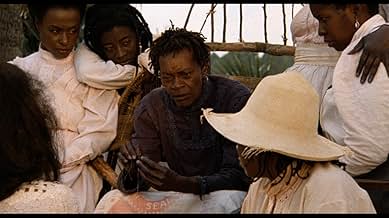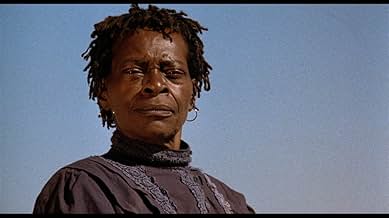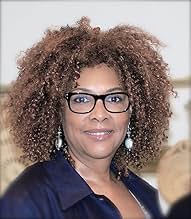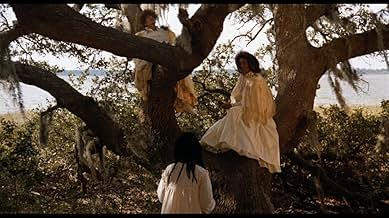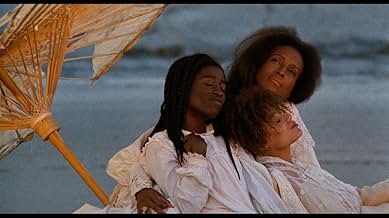IMDb-BEWERTUNG
6,6/10
3643
IHRE BEWERTUNG
Füge eine Handlung in deiner Sprache hinzuA languid, impressionistic story of three generations of Gullah women living on the South Carolina Sea Islands in 1902.A languid, impressionistic story of three generations of Gullah women living on the South Carolina Sea Islands in 1902.A languid, impressionistic story of three generations of Gullah women living on the South Carolina Sea Islands in 1902.
- Auszeichnungen
- 4 Gewinne & 2 Nominierungen insgesamt
Barbara O
- Yellow Mary
- (as Barbara-O)
Tony King
- Newlywed Man
- (as Malik Farrakhan)
Empfohlene Bewertungen
Julie Dash grew up in Long Island, New York and graduated from CCNY right after high school with a degree in film production. Dash moved to L.A. only to be rejected by UCLA's film department, but later accepted as a student of the American Film Institute through a fellowship. Grants then started rolling in and Dash was able to begin writing and shooting films which revolved around true historical portrayals and images of African woman such as depicted in Daughters of the Dust. This film was written, directed and then released by Julie Dash in 1991. The historical context of this film stretches from the time of the slave trade up to the summer of 1902, when the Peazant family left an island off the coast of South Carolina and headed north for the mainland. I would consider this film to be within the genre of modern melodrama because of the overly emotional acting styles, complex plot, long monologues and excellent musical score which seems to parallel the moods in each scene perfectly. I also found the mis en scene, as far as the setting, costume, figure movement and expression and cinematography to be very well done. This is an intense film definitely worth watching.
"Daughters of the Dust" isn't an easy work, but it's a very fine accomplishment, and one of the most important African American films of the last 20 years.
Julie Dash has chosen to share with her audience a chapter of black history that is still new to most white Americans, the internal issues that came with Black Americans as they made their way North in the years between 1900 and 1920. The separation from the soil, the divorce from those remnants of West African culture that survived through the holocaust of slavery. The psychic tearing of the transition from rural to urban culture. The skin game that Yellow Mary and other "fair skinned" Black people had to play in order to survive in White America. If the film is boring to many, let it be plainly said that it is boring for many because the film maker courageously chose to examine a piece of history that most White Americans- and many Black ones- no longer care much about.
If you want to be entertained, this isn't a film you'll enjoy. "Daughters of the Dust" offers instead an opportunity to probe deep, to look close at the dreamy quality of an internal life, and a balanced relationship with the earth, that most of our peoples in the United States have chosen to leave behind them for exactly the wrong reasons. Let those who have difficulty thinking about these things stick to action films. "Daughters of the Dust" is about something more akin to the sense of wonder that's being rapidly stamped out of many of us in the name of mom, apple pie, and the gross national product. It is worth not one, but many viewings. Julie Dash has created a masterpiece of American cinema.
Julie Dash has chosen to share with her audience a chapter of black history that is still new to most white Americans, the internal issues that came with Black Americans as they made their way North in the years between 1900 and 1920. The separation from the soil, the divorce from those remnants of West African culture that survived through the holocaust of slavery. The psychic tearing of the transition from rural to urban culture. The skin game that Yellow Mary and other "fair skinned" Black people had to play in order to survive in White America. If the film is boring to many, let it be plainly said that it is boring for many because the film maker courageously chose to examine a piece of history that most White Americans- and many Black ones- no longer care much about.
If you want to be entertained, this isn't a film you'll enjoy. "Daughters of the Dust" offers instead an opportunity to probe deep, to look close at the dreamy quality of an internal life, and a balanced relationship with the earth, that most of our peoples in the United States have chosen to leave behind them for exactly the wrong reasons. Let those who have difficulty thinking about these things stick to action films. "Daughters of the Dust" is about something more akin to the sense of wonder that's being rapidly stamped out of many of us in the name of mom, apple pie, and the gross national product. It is worth not one, but many viewings. Julie Dash has created a masterpiece of American cinema.
Daughters in the Dust is one of those rare movies that truly makes you wonder long and hard about the possibilities of the film form. The film as pure narrative leaves much to be desired; yet it's is not concerned about telling the intricate and sentimental goings-on of one or two human beings; a single tale told in one moment in time. No, the film's scope is much wider and anthropological in scale, thus requires more than just a passing judgment on its entertainment value.
The film concerns itself with the Peazant family; proud members of Gullah creoles who originated from slaves traded along the remote islets of South Carolina and Georgia. Even before the Civil War generations of the Gullah people lived quietly as rice farmers on these islands and thanks in large part to regional isolation they were able to rebuild and retain much of the linguistic, cultural and religious heritage that had been wiped out by the slave trade. By 1901, the Peazants are mulling over the idea of relocating to the mainland.
The film has the narrative distinction of being told from the perspective of an unnamed and unborn member of the Peazants played by Kay-Lynn Warren. At only four, the young Warren peeks through the hole of her family's history only appearing twice herself as a sprite. We meet her pregnant mother Eula (Rogers), her aunts Haagar (Moore), Viola (Bruce) and Yellow Mary (Barbara-O) as well as Nana (Day) the matriarch of the family. Nana is old enough to remember the scourge of slavery and as a result is resonant to move to the mainland. Meanwhile Haagar is the strongest advocate for the move saying "If Nana wants to live and die on this island, then God bless her old soul." Two members of the clan have already moved away; Viola who moved to Philadelphia to become a ardent Christian; and Yellow Mary, who according to Viola is a "wasted woman".
Despite showcasing a family hungry for change and progress, the film gives proper reverence to the traditions of the Gullah people. The most respected people on the island are the elders who consist of Nana and Bilal Muhammad (Abdurrahman) the resident mullah. The spiritual ceremonies of the family relies on a mixture of Christianity, Islam and African animism that gives everything natural around them a lyrical quality. Yet underneath the pleasant depictions of sun-soaked beaches and marshy lowlands the internal conflict behind the eyes of the Peazants can't help but surface during communal gatherings. "We are two people in one body," says Nana as she defies the rest of the family who hope to travel north with their hopes and dreams.
If there is one glaring problem with Daughters of the Dust it's its expectations of the viewer. During production director Julie Dash wanted to keep the authenticity of the people intact and thus had actors speak only in the Gullah dialect and didn't consider subtitles. A minority of audience members may find this tact a mesmerizing exercise in linguistics. A feeling not unlike hearing the warm familiar sounds of your parents speaking while you were a toddler. From a purely anthropological perspective this was the best narrative choice one could hope for, allowing those with patience further rewards with repeated viewings. Unfortunately if you're not one of patience or a strong interest in anthropology or etymology you might find yourself distracted and looking for other stimuli.
There are many ways to read a movie of this nature. Most movies start and end with a graspable narrative, quick and easy explanations to plot details and an clear resolution. Daughters of the Dust doesn't let you off the hook with easy solutions. It instead asks serious questions. Questions that highlight the consequences of modernity's encroachment on tradition, cultural identity, cross-generational turmoil and diaspora. Furthermore the movie gives willing audiences a sense of belonging among the Gullah people; a warmth you seldom feel on the screen. It also does so in a very spirited and exquisite way featuring some of the most lyrical visual storytelling $800,000 can buy.
The film concerns itself with the Peazant family; proud members of Gullah creoles who originated from slaves traded along the remote islets of South Carolina and Georgia. Even before the Civil War generations of the Gullah people lived quietly as rice farmers on these islands and thanks in large part to regional isolation they were able to rebuild and retain much of the linguistic, cultural and religious heritage that had been wiped out by the slave trade. By 1901, the Peazants are mulling over the idea of relocating to the mainland.
The film has the narrative distinction of being told from the perspective of an unnamed and unborn member of the Peazants played by Kay-Lynn Warren. At only four, the young Warren peeks through the hole of her family's history only appearing twice herself as a sprite. We meet her pregnant mother Eula (Rogers), her aunts Haagar (Moore), Viola (Bruce) and Yellow Mary (Barbara-O) as well as Nana (Day) the matriarch of the family. Nana is old enough to remember the scourge of slavery and as a result is resonant to move to the mainland. Meanwhile Haagar is the strongest advocate for the move saying "If Nana wants to live and die on this island, then God bless her old soul." Two members of the clan have already moved away; Viola who moved to Philadelphia to become a ardent Christian; and Yellow Mary, who according to Viola is a "wasted woman".
Despite showcasing a family hungry for change and progress, the film gives proper reverence to the traditions of the Gullah people. The most respected people on the island are the elders who consist of Nana and Bilal Muhammad (Abdurrahman) the resident mullah. The spiritual ceremonies of the family relies on a mixture of Christianity, Islam and African animism that gives everything natural around them a lyrical quality. Yet underneath the pleasant depictions of sun-soaked beaches and marshy lowlands the internal conflict behind the eyes of the Peazants can't help but surface during communal gatherings. "We are two people in one body," says Nana as she defies the rest of the family who hope to travel north with their hopes and dreams.
If there is one glaring problem with Daughters of the Dust it's its expectations of the viewer. During production director Julie Dash wanted to keep the authenticity of the people intact and thus had actors speak only in the Gullah dialect and didn't consider subtitles. A minority of audience members may find this tact a mesmerizing exercise in linguistics. A feeling not unlike hearing the warm familiar sounds of your parents speaking while you were a toddler. From a purely anthropological perspective this was the best narrative choice one could hope for, allowing those with patience further rewards with repeated viewings. Unfortunately if you're not one of patience or a strong interest in anthropology or etymology you might find yourself distracted and looking for other stimuli.
There are many ways to read a movie of this nature. Most movies start and end with a graspable narrative, quick and easy explanations to plot details and an clear resolution. Daughters of the Dust doesn't let you off the hook with easy solutions. It instead asks serious questions. Questions that highlight the consequences of modernity's encroachment on tradition, cultural identity, cross-generational turmoil and diaspora. Furthermore the movie gives willing audiences a sense of belonging among the Gullah people; a warmth you seldom feel on the screen. It also does so in a very spirited and exquisite way featuring some of the most lyrical visual storytelling $800,000 can buy.
Daughters of The Dust was produced by Geechee Girls and American Playhouse Company. The movie main focus is on the Peazant women. Nana Peazant is played by Cora Lee Day, and Eula, her granddaughter, is played by Alva Rogers who is pregnant and has been raped by a landowner. Nana's granddaughter, Yellow Mary, is played by Barbara-O who is returning, with her friend Trula, from the mainland and her life as a prostitute and wet nurse. Haggar, who has married into the family, is played by Kaycee Moore and wants nothing to do with the old traditions. Similarly, the Christian Viola, played by Cheryl Lynn Bruce, is returning from her life on the mainland.
Daughters of the Dust is a film written and directed by Julie Dash. It tells the story of a family of African-Americans who have lived for many years on a Southern offshore island, and of how they come together one day in 1902 to celebrate their ancestors before some of them leave for the North. The film is narrated by an unborn child, and ancestors already dead also seem to be as present as the living.
Julie Dash underwent many hardships in bringing the story to the silver screen. She had severe budget constraints, filmed in mosquito and insect infested areas, was delayed by Hurricane Hugo, sidetracked by sudden and violent sandstorms, and was forced to decide to either have a child or make the movie. In the end, she choose to give birth and nurture the story Daugthers of the Dust and the result is an unconventional masterpiece.
Initially, the response by white male critics was not favorable and they accused Dash of not adequately explaining the Gullah people, their culture, and their religious traditions. While attacking Dash, these critics failed to acknowledge many positive aspects of the film. The reasons behind this, according to Bell Hooks, is that "we've never been taught, most of us, in any history class that black people had different languages, had different religious practices, etc. So, to some extent, the film represents that challenge to a critic of any race" to review something they are not familiar with.
Because of these reviews and the fact that movie tells the story of African American women in an unconventional manner, it would seem to have slim commercial prospects. However, through word of mouth and some positive reviews it was able to generate a cult following. To date, the film has grossed 1.6 million from a budget of only 800,000.
The Newark Black Film Festival has chosen Daughters as the Film of The Century while the British Film Institute's Sight and Sound Magazine chose the soundtrack as one of the best in the past 25 years. It also received the Best Cinematography award at the Sundance Film Festival in 1991.
I believe the film hits the viewer on various levels. By placing the story in the early 1900's, Dash is able to show us a turbulent time for African-Americans and address many issues such as migration, lynching, and the changing African-American culture. Dash also shows and teaches us about Ibo culture and it's importance in the lives of those inhabiting the Sea Coast Islands, not just the African-Americans sharing the Gullah culture, but also the Native Americans, Muslims, and Christians.
Daughters of the Dust is a film written and directed by Julie Dash. It tells the story of a family of African-Americans who have lived for many years on a Southern offshore island, and of how they come together one day in 1902 to celebrate their ancestors before some of them leave for the North. The film is narrated by an unborn child, and ancestors already dead also seem to be as present as the living.
Julie Dash underwent many hardships in bringing the story to the silver screen. She had severe budget constraints, filmed in mosquito and insect infested areas, was delayed by Hurricane Hugo, sidetracked by sudden and violent sandstorms, and was forced to decide to either have a child or make the movie. In the end, she choose to give birth and nurture the story Daugthers of the Dust and the result is an unconventional masterpiece.
Initially, the response by white male critics was not favorable and they accused Dash of not adequately explaining the Gullah people, their culture, and their religious traditions. While attacking Dash, these critics failed to acknowledge many positive aspects of the film. The reasons behind this, according to Bell Hooks, is that "we've never been taught, most of us, in any history class that black people had different languages, had different religious practices, etc. So, to some extent, the film represents that challenge to a critic of any race" to review something they are not familiar with.
Because of these reviews and the fact that movie tells the story of African American women in an unconventional manner, it would seem to have slim commercial prospects. However, through word of mouth and some positive reviews it was able to generate a cult following. To date, the film has grossed 1.6 million from a budget of only 800,000.
The Newark Black Film Festival has chosen Daughters as the Film of The Century while the British Film Institute's Sight and Sound Magazine chose the soundtrack as one of the best in the past 25 years. It also received the Best Cinematography award at the Sundance Film Festival in 1991.
I believe the film hits the viewer on various levels. By placing the story in the early 1900's, Dash is able to show us a turbulent time for African-Americans and address many issues such as migration, lynching, and the changing African-American culture. Dash also shows and teaches us about Ibo culture and it's importance in the lives of those inhabiting the Sea Coast Islands, not just the African-Americans sharing the Gullah culture, but also the Native Americans, Muslims, and Christians.
Daughters of the Dust directed by Julie Dash is a cultural perspective look into the lives of an African American family left on an island years after being torn from their heritage of Africa for slavery only to have revolted and be left to themselves, stranded on the island off the coast of the Southern eastern coast and the family who live off the island with others who long to find their heritage. The film's story line is developed in the one day where the family is getting ready to head to a new world on the main land. The internal conflict of the family between relatives who no longer live on the island who have become part of the culture of America post civil war and the family left on the island that live by the old heritage and customs. The family on the island struggle between their history and culture to the change of the times and the need for conformity. This film centers on the generations of the family from the young children who are filled with life then to the adults who are torn between their decisions to leave to finally the center character, the elder grandmother of the family Nana. Nana's ways and beliefs that have been accepted by the family their entire lives are now the only thing holding the family back from their future off the island. The film focuses largely on the women of the family, displaying the differences of ones who that have lived on the island and then those whom have lived off it. The lines divided between the two are evidently shown throughout the film. The women who lived off the island no longer take to heart their heritage that Nana lives by. They find it to be uncivilized and against the teaching of the bible. There is the scene in which the family after much struggle and torment accept Nana's decision to stay and her heritage. The scene is of the entire family gathered around the grandmother in which she has a lock of her hair and others placed on a bible asking everyone to believe in the old ways and take her with her by kissing the hair and bible. Finally, the scene acts as importance because one of the outside family members whom diligently preaches and believes in Christianity gives in to Nana's request.
Daughters of the Dust cannot be explained without stating the mise en cinema. From the clothing to the shots of the landscape of the island all resemble the time and place of the film. Not only the background and clothes, but also the character themselves turn this limited distributed film into a believable representation of what people of this time would act and be. The storyline background of the slavery uprising actually having taken place on the island gives it enormous creditability. The shots of the island start the creditability of the film with shots of the women interacting with the water of the ocean and the rivers, the shots of the forest and trees, and finally the most significant may be when the women are preparing the dinner showing how their food is prepared with live seafood and spices gathered from the island. The mise en cinema is creditable because of the clothes as well; from Nana who has only a dress is indigo, which was the main produce to harvest by the slaves on the island to the white Victorian dress of the women from the main land.
Dash's Daughters of the Dust cannot be denied as a cultural perspective that's originality has touched on the transition to the new culture of African Americans and they past that many have forgotten after the postwar civil war era. Its cultural insight may have been directed to a certain selected target audience, but its look into the heritage of the people cannot be viewed as anything but a respectable insight of the times.
Daughters of the Dust cannot be explained without stating the mise en cinema. From the clothing to the shots of the landscape of the island all resemble the time and place of the film. Not only the background and clothes, but also the character themselves turn this limited distributed film into a believable representation of what people of this time would act and be. The storyline background of the slavery uprising actually having taken place on the island gives it enormous creditability. The shots of the island start the creditability of the film with shots of the women interacting with the water of the ocean and the rivers, the shots of the forest and trees, and finally the most significant may be when the women are preparing the dinner showing how their food is prepared with live seafood and spices gathered from the island. The mise en cinema is creditable because of the clothes as well; from Nana who has only a dress is indigo, which was the main produce to harvest by the slaves on the island to the white Victorian dress of the women from the main land.
Dash's Daughters of the Dust cannot be denied as a cultural perspective that's originality has touched on the transition to the new culture of African Americans and they past that many have forgotten after the postwar civil war era. Its cultural insight may have been directed to a certain selected target audience, but its look into the heritage of the people cannot be viewed as anything but a respectable insight of the times.
Wusstest du schon
- WissenswertesSelected to the Library of Congress National Registry of Film in 2004.
- Zitate
[first lines]
Nana Peazant: I am the first and the last. I am the honored one and the scorned one. I am the whore and the holy one. I am the wife and the virgin. I am the barren one and many are my daughters. I am the silence that you can not understand. I am the utterance of my name.
Top-Auswahl
Melde dich zum Bewerten an und greife auf die Watchlist für personalisierte Empfehlungen zu.
- How long is Daughters of the Dust?Powered by Alexa
Details
Box Office
- Bruttoertrag in den USA und Kanada
- 1.683.422 $
- Eröffnungswochenende in den USA und in Kanada
- 10.842 $
- 20. Nov. 2016
- Weltweiter Bruttoertrag
- 1.689.776 $
- Laufzeit
- 1 Std. 53 Min.(113 min)
- Farbe
- Seitenverhältnis
- 1.85 : 1
Zu dieser Seite beitragen
Bearbeitung vorschlagen oder fehlenden Inhalt hinzufügen






